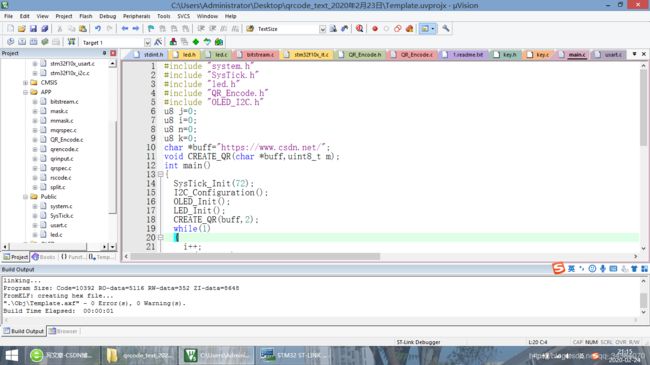STM32F103C8T6使用0.96寸OLED显示QR二维码
一.功能说明
使用STM32F103C8T6把字符信息转换QR code在0.96寸OLED显示


二.硬件&软件
硬件:STM32F103C8T6最小系统 、4线IIC0.96寸OLED、ST_LINK下载器、杜邦线若干。
软件:windows pc、KEIL5
三.实现过程
硬件:
STM32 OLED
GND -----> GND
VCC -----> VCC
PB7 -----> SDA
PB6 -----> SCL
软件程序:
1.移植QR code 底层驱动到stm32工程,下图是工程截图,APP里面则驱动

2.OLED 驱动
绘制二维码主要用OLED 的花点函数
void OLED_DrawPoint( uint8_t x,uint8_t y,uint8_t mode )
#include "OLED_I2C.h"
#include "SysTick.h"
#include "codetab.h"
#include "math.h"
void I2C_Configuration(void)
{
I2C_InitTypeDef I2C_InitStructure;
GPIO_InitTypeDef GPIO_InitStructure;
RCC_APB1PeriphClockCmd(RCC_APB1Periph_I2C1,ENABLE);
RCC_APB2PeriphClockCmd(RCC_APB2Periph_GPIOB,ENABLE);
/*STM32F103C8T6芯片的硬件I2C: PB6 -- SCL; PB7 -- SDA */
GPIO_InitStructure.GPIO_Pin = GPIO_Pin_6 | GPIO_Pin_7;
GPIO_InitStructure.GPIO_Speed = GPIO_Speed_50MHz;
GPIO_InitStructure.GPIO_Mode = GPIO_Mode_AF_OD;//I2C必须开漏输出
GPIO_Init(GPIOB, &GPIO_InitStructure);
I2C_DeInit(I2C1);//使用I2C1
I2C_InitStructure.I2C_Mode = I2C_Mode_I2C;
I2C_InitStructure.I2C_DutyCycle = I2C_DutyCycle_2;
I2C_InitStructure.I2C_OwnAddress1 = 0x30;//主机的I2C地址,随便写的
I2C_InitStructure.I2C_Ack = I2C_Ack_Enable;
I2C_InitStructure.I2C_AcknowledgedAddress = I2C_AcknowledgedAddress_7bit;
I2C_InitStructure.I2C_ClockSpeed = 400000;//400K
I2C_Cmd(I2C1, ENABLE);
I2C_Init(I2C1, &I2C_InitStructure);
}
void I2C_WriteByte(uint8_t addr,uint8_t data)
{
while(I2C_GetFlagStatus(I2C1, I2C_FLAG_BUSY));
I2C_GenerateSTART(I2C1, ENABLE);//开启I2C1
while(!I2C_CheckEvent(I2C1, I2C_EVENT_MASTER_MODE_SELECT));/*EV5,主模式*/
I2C_Send7bitAddress(I2C1, OLED_ADDRESS, I2C_Direction_Transmitter);//器件地址 -- 默认0x78
while(!I2C_CheckEvent(I2C1, I2C_EVENT_MASTER_TRANSMITTER_MODE_SELECTED));
I2C_SendData(I2C1, addr);//寄存器地址
while (!I2C_CheckEvent(I2C1, I2C_EVENT_MASTER_BYTE_TRANSMITTED));
I2C_SendData(I2C1, data);//发送数据
while (!I2C_CheckEvent(I2C1, I2C_EVENT_MASTER_BYTE_TRANSMITTED));
I2C_GenerateSTOP(I2C1, ENABLE);//关闭I2C1总线
}
void WriteCmd(unsigned char I2C_Command)//写命令
{
I2C_WriteByte(0x00, I2C_Command);
}
void WriteDat(unsigned char I2C_Data)//写数据
{
I2C_WriteByte(0x40, I2C_Data);
}
void OLED_Init(void)
{
delay_ms(100); //这里的延时很重要
WriteCmd(0xAE); //display off
WriteCmd(0x20); //Set Memory Addressing Mode
WriteCmd(0x10); //00,Horizontal Addressing Mode;01,Vertical Addressing Mode;10,Page Addressing Mode (RESET);11,Invalid
WriteCmd(0xb0); //Set Page Start Address for Page Addressing Mode,0-7
WriteCmd(0xc8); //Set COM Output Scan Direction
WriteCmd(0x00); //---set low column address
WriteCmd(0x10); //---set high column address
WriteCmd(0x40); //--set start line address
WriteCmd(0x81); //--set contrast control register
WriteCmd(0xff); //亮度调节 0x00~0xff
WriteCmd(0xa1); //--set segment re-map 0 to 127
WriteCmd(0xa6); //--set normal display
WriteCmd(0xa8); //--set multiplex ratio(1 to 64)
WriteCmd(0x3F); //
WriteCmd(0xa4); //0xa4,Output follows RAM content;0xa5,Output ignores RAM content
WriteCmd(0xd3); //-set display offset
WriteCmd(0x00); //-not offset
WriteCmd(0xd5); //--set display clock divide ratio/oscillator frequency
WriteCmd(0xf0); //--set divide ratio
WriteCmd(0xd9); //--set pre-charge period
WriteCmd(0x22); //
WriteCmd(0xda); //--set com pins hardware configuration
WriteCmd(0x12);
WriteCmd(0xdb); //--set vcomh
WriteCmd(0x20); //0x20,0.77xVcc
WriteCmd(0x8d); //--set DC-DC enable
WriteCmd(0x14); //
WriteCmd(0xaf); //--turn on oled panel
}
void OLED_SetPos(unsigned char x, unsigned char y) //设置起始点坐标
{
WriteCmd(0xb0+y);
WriteCmd(((x&0xf0)>>4)|0x10);
WriteCmd((x&0x0f)|0x01);
}
void OLED_Fill(unsigned char fill_Data)//全屏填充
{
unsigned char m,n;
for(m=0;m<8;m++)
{
WriteCmd(0xb0+m); //page0-page1
WriteCmd(0x00); //low column start address
WriteCmd(0x10); //high column start address
for(n=0;n<128;n++)
{
WriteDat(fill_Data);
}
}
}
void OLED_CLS(void)//清屏
{
OLED_Fill(0x00);
}
//--------------------------------------------------------------
// Prototype : void OLED_ON(void)
// Calls :
// Parameters : none
// Description : 将OLED从休眠中唤醒
//--------------------------------------------------------------
void OLED_ON(void)
{
WriteCmd(0X8D); //设置电荷泵
WriteCmd(0X14); //开启电荷泵
WriteCmd(0XAF); //OLED唤醒
}
//--------------------------------------------------------------
// Prototype : void OLED_OFF(void)
// Calls :
// Parameters : none
// Description : 让OLED休眠 -- 休眠模式下,OLED功耗不到10uA
//--------------------------------------------------------------
void OLED_OFF(void)
{
WriteCmd(0X8D); //设置电荷泵
WriteCmd(0X10); //关闭电荷泵
WriteCmd(0XAE); //OLED休眠
}
//--------------------------------------------------------------
// Prototype : void OLED_ShowChar(unsigned char x, unsigned char y, unsigned char ch[], unsigned char TextSize)
// Calls :
// Parameters : x,y -- 起始点坐标(x:0~127, y:0~7); ch[] -- 要显示的字符串; TextSize -- 字符大小(1:6*8 ; 2:8*16)
// Description : 显示codetab.h中的ASCII字符,有6*8和8*16可选择
//--------------------------------------------------------------
void OLED_ShowStr(unsigned char x, unsigned char y, unsigned char ch[], unsigned char TextSize)
{
unsigned char c = 0,i = 0,j = 0;
switch(TextSize)
{
case 1:
{
while(ch[j] != '\0')
{
c = ch[j] - 32;
if(x > 126)
{
x = 0;
y++;
}
OLED_SetPos(x,y);
for(i=0;i<6;i++)
WriteDat(F6x8[c][i]);
x += 6;
j++;
}
}break;
case 2:
{
while(ch[j] != '\0')
{
c = ch[j] - 32;
if(x > 120)
{
x = 0;
y++;
}
OLED_SetPos(x,y);
for(i=0;i<8;i++)
WriteDat(F8X16[c*16+i]);
OLED_SetPos(x,y+1);
for(i=0;i<8;i++)
WriteDat(F8X16[c*16+i+8]);
x += 8;
j++;
}
}break;
}
}
//--------------------------------------------------------------
// Prototype : void OLED_ShowCN(unsigned char x, unsigned char y, unsigned char N)
// Calls :
// Parameters : x,y -- 起始点坐标(x:0~127, y:0~7); N:汉字在codetab.h中的索引
// Description : 显示codetab.h中的汉字,16*16点阵
//--------------------------------------------------------------
void OLED_ShowCN(unsigned char x, unsigned char y, unsigned char N)
{
unsigned char wm=0;
unsigned int adder=32*N;
OLED_SetPos(x , y);
for(wm = 0;wm < 16;wm++)
{
WriteDat(F16x16[adder]);
adder += 1;
}
OLED_SetPos(x,y + 1);
for(wm = 0;wm < 16;wm++)
{
WriteDat(F16x16[adder]);
adder += 1;
}
}
//--------------------------------------------------------------
// Prototype : void OLED_DrawBMP(unsigned char x0,unsigned char y0,unsigned char x1,unsigned char y1,unsigned char BMP[]);
// Calls :
// Parameters : x0,y0 -- 起始点坐标(x0:0~127, y0:0~7); x1,y1 -- 起点对角线(结束点)的坐标(x1:1~128,y1:1~8)
// Description : 显示BMP位图
//--------------------------------------------------------------
void OLED_DrawBMP(unsigned char x0,unsigned char y0,unsigned char x1,unsigned char y1,unsigned char BMP[])
{
unsigned int j=0;
unsigned char x,y;
if(y1%8==0)
y = y1/8;
else
y = y1/8 + 1;
for(y=y0;y127||y>63)return;
i=7-y/8;//算出第几页
j=y%8;
temp=0x01<<(7-j);//由位运算精确找出坐标像素点
if(mode==0)
OLED_GRAM[x][i]&=~temp;
else
OLED_GRAM[x][i]|=temp;
}
//更新显存到LCD
void OLED_Refresh_Gram(void)
{
u8 i,n;
for(i=0;i<8;i++)
{
WriteCmd (0xb0+i); //设置页地址(0~7)
WriteCmd (0x00); //设置显示位置—列低地址
WriteCmd (0x10); //设置显示位置—列高地址
for(n=0;n<128;n++)WriteDat(OLED_GRAM[n][i]);
}
}
void draw_circle(u8 x0,u8 y0,u8 r) //圆心(x0,y0),半径r
{
u8 x,y;
for(x = 0;x <= 63;x++){
y = sqrt(pow(r,2)-pow(x-x0,2))+y0; //圆方程 x,y反置
OLED_DrawPoint(y,x,1); //上半圆
OLED_DrawPoint(63-y,x,1); //下半圆
}
}
3.mian函数实现
#include "system.h"
#include "SysTick.h"
#include "led.h"
#include "QR_Encode.h"
#include "OLED_I2C.h"
u8 j=0;
u8 i=0;
u8 n=0;
u8 k=0;
char *buff="https://www.csdn.net/";
void CREATE_QR(char *buff,uint8_t m);
int main()
{
SysTick_Init(72);
I2C_Configuration();
OLED_Init();
LED_Init();
CREATE_QR(buff,2);
while(1)
{
i++;
if(i%20==0)
{
led1=!led1;
}
delay_ms(100);
}}
/***************************************
--------------------------------------------------------------
Prototype : void CREATE_QR(char *buff,uint8_t m)
Calls :
Parameters : buff:需要显示的字符串 m:二维码像素点放大倍数
Description : 二维码在OLED12864上显示
--------------------------------------------------------------
**************************************/
void CREATE_QR(char *buff,uint8_t m)
{
EncodeData(buff); //编码数据
for(i=0;i下载地址:https://download.csdn.net/download/qq_34384070/12189072